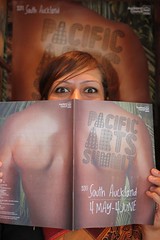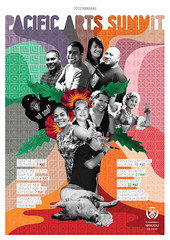The final event in the 2011 South Auckland Pacific Arts Summit was the launch of the 2011 Pacific Dance Artist in Residence programme, delivered by Pacific Dance New Zealand with support from DANZ and Creative New Zealand’s Pacific Arts Committee.
BIG congratulations to Keneti Muaiava, the recipient of this year’s residency!
- Read more about Keneti’s residency project
- Keneti and Mau Maiava’s company, Vision Cultural Movement
 MP Su’a William Sio, Filoi Vaila’au (Pacific Dance New Zealand) and Keneti Muaiava
MP Su’a William Sio, Filoi Vaila’au (Pacific Dance New Zealand) and Keneti Muaiava
 Guest speaker, Mangere MP Su’a William Sio
Guest speaker, Mangere MP Su’a William Sio


 Makerita Urale, Senior Programme Adviser – Pacific Arts Portfolio, Creative New Zealand
Makerita Urale, Senior Programme Adviser – Pacific Arts Portfolio, Creative New Zealand


Makerita Urale (Creative New Zealand), MP Su’a William Sio, Keneti Muaiava and Susan Jordan (DANZ)
 The PDNZ documentary team, Aaron Taouma + Popo Lilo
The PDNZ documentary team, Aaron Taouma + Popo Lilo
 Ema Tavola (Auckland Council) and Mangere MP Su’a William Sio
Ema Tavola (Auckland Council) and Mangere MP Su’a William Sio
Pacific Dance New Zealand in association with DANZ, Auckland Council and Creative New Zealand are calling for dancers to take part in the Pacific Dance Artist in Residence programme 2011.
This exciting eight-week dance residency is offered to an established New Zealand based dancer, dance choreographer or a director of Pacific Island descent with a proven track record of working in a community and or professional theatre context.
This year’s Pacific Dance Artist in Residence, Keneti Muaiava, is a master dancer specialising in Samoan dance. He is the co-founder for Vision Cultural Movement; an organisation that specialises in the maintenance of Samoan heritage arts & culture in Aotearoa.
The residency programme runs between Saturday 4June and Saturday 30 July 2011.
Keneti’s residency project is called “Past, Present and Future” and is centred around the teaching and development of three distinct Samoan dance styles whereby community dancers will have the opportunity to imbue themselves in the concepts and culture behind the movements while also exploring contextual elements making the dances both “authentic and relevant.”
This is a great opportunity for dancers from a variety of backgrounds to learn the Samoan dance styles of the Sasa, Fa’ataupati (slap dance) and ma’ulu’ulu (action dance) from a master teacher (tofuga) such as Keneti.
The residency will also allow for experimentation in the dance forms once the basic heritage form is learnt and will culminate in a final showing at the Metro Theatre on Saturday 30 July.
Dancers will partake in workshops for three days a week (three hours per day) but are not expected to have any prior knowledge of the dance forms, although this would help in the learning phases.
For registration and enquiries please email auckland@pacificdance.co.nz or phone Filoi Vaila’au on 09 370 0487.




















 Dagmar Dyke + Christina Jeffery (
Dagmar Dyke + Christina Jeffery ( Lealiifano Albert Refiti (AUT University), Safua Akeli (Te Papa Tongarewa – Museum of New Zealand), Jim Vivieaere + Angela Tiatia
Lealiifano Albert Refiti (AUT University), Safua Akeli (Te Papa Tongarewa – Museum of New Zealand), Jim Vivieaere + Angela Tiatia
 Nicole Lim (Fresh Gallery Otara), Margaret Aull (Te Wananga o Aotearoa) + Gareth Dyer (
Nicole Lim (Fresh Gallery Otara), Margaret Aull (Te Wananga o Aotearoa) + Gareth Dyer ( Ema Tavola + Leafa Wilson
Ema Tavola + Leafa Wilson The final panel: Ema Tavola (Fresh Gallery Otara), Leafa Wilson (Waikato Museum), Dionne Fonoti (National University of Samoa / Ivilasi Films), Bruce E. Phillips (Te Tuhi Centre for the Arts) and Luisa Tora.
The final panel: Ema Tavola (Fresh Gallery Otara), Leafa Wilson (Waikato Museum), Dionne Fonoti (National University of Samoa / Ivilasi Films), Bruce E. Phillips (Te Tuhi Centre for the Arts) and Luisa Tora.
 Sean Mallon (Te Papa Tongarewa – Museum of New Zealand) with Fulimalo Pereira (Auckland Museum) and her daughter.
Sean Mallon (Te Papa Tongarewa – Museum of New Zealand) with Fulimalo Pereira (Auckland Museum) and her daughter. Leafa Wilson, Luisa Tora + Daniel Satele
Leafa Wilson, Luisa Tora + Daniel Satele Ian Wedde + Bruce E. Phillips
Ian Wedde + Bruce E. Phillips Ema Tavola, Karl Chitham + Leafa Wilson
Ema Tavola, Karl Chitham + Leafa Wilson Our excellent MC, Nigel Borell (Kaiwhakahaere – Maori Arts Advisor, Auckland Council South) with Kolokesa Mahina-Tuai and friend.
Our excellent MC, Nigel Borell (Kaiwhakahaere – Maori Arts Advisor, Auckland Council South) with Kolokesa Mahina-Tuai and friend. Otara’s own, Pele – completely at home on this stage!
Otara’s own, Pele – completely at home on this stage!
















